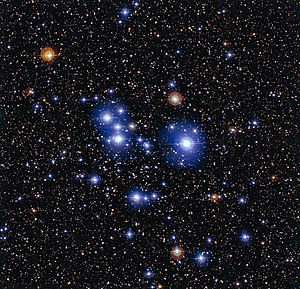Messier 47: Difference between revisions
No edit summary |
No edit summary |
||
| Line 1: | Line 1: | ||
[[File:Eso1441a.jpg|thumb|Messier 47]] | |||
Messier 47 (Messier Object 47, M47, or NGC 2422) is an open cluster in the constellation [[Puppis]]. It was discovered by Giovanni Batista Hodierna before 1654 and independently discovered by Charles Messier on February 19, 1771. It was later independently discovered again, under the current name NGC 2422. | Messier 47 (Messier Object 47, M47, or NGC 2422) is an open cluster in the constellation [[Puppis]]. It was discovered by Giovanni Batista Hodierna before 1654 and independently discovered by Charles Messier on February 19, 1771. It was later independently discovered again, under the current name NGC 2422. | ||
There is actually no cluster in the position indicated by Messier, which he expressed in terms of its right ascension and declination with respect to the star 2 Puppis. However, if the signs of Messier's coordinate differences are changed, the position matches that of NGC 2422.[1] Until the equivalency of M47 with NGC2422 was found, M47 was considered a lost Messier Object. The discovery that M47 and NGC2422 were the same cluster only came in 1959 with a realization by Canadian astronomer T. F. Morris. | There is actually no cluster in the position indicated by Messier, which he expressed in terms of its right ascension and declination with respect to the star 2 Puppis. However, if the signs of Messier's coordinate differences are changed, the position matches that of NGC 2422.[1] Until the equivalency of M47 with NGC2422 was found, M47 was considered a lost Messier Object. The discovery that M47 and NGC2422 were the same cluster only came in 1959 with a realization by Canadian astronomer T. F. Morris. | ||
M47 is at a distance of about 1,600 light-years from Earth with an estimated age of about 78 million years. There are about 50 stars in this cluster, the brightest one being of magnitude +5.7. M47 is located relatively close in the sky to Messier 46, which is much older and much further away.<ref>[http://en.wikipedia.org/wiki/Messier_47 Messier 47]</ref> | M47 is at a distance of about 1,600 light-years from Earth with an estimated age of about 78 million years. There are about 50 stars in this cluster, the brightest one being of magnitude +5.7. M47 is located relatively close in the sky to Messier 46, which is much older and much further away.<ref>[http://en.wikipedia.org/wiki/Messier_47 Messier 47]</ref> | ||
Latest revision as of 23:37, 3 April 2015
Messier 47 (Messier Object 47, M47, or NGC 2422) is an open cluster in the constellation Puppis. It was discovered by Giovanni Batista Hodierna before 1654 and independently discovered by Charles Messier on February 19, 1771. It was later independently discovered again, under the current name NGC 2422. There is actually no cluster in the position indicated by Messier, which he expressed in terms of its right ascension and declination with respect to the star 2 Puppis. However, if the signs of Messier's coordinate differences are changed, the position matches that of NGC 2422.[1] Until the equivalency of M47 with NGC2422 was found, M47 was considered a lost Messier Object. The discovery that M47 and NGC2422 were the same cluster only came in 1959 with a realization by Canadian astronomer T. F. Morris.
M47 is at a distance of about 1,600 light-years from Earth with an estimated age of about 78 million years. There are about 50 stars in this cluster, the brightest one being of magnitude +5.7. M47 is located relatively close in the sky to Messier 46, which is much older and much further away.[1]
References
Found in HGS Manual on Page 108 Found in HGS Manual on Page 115


